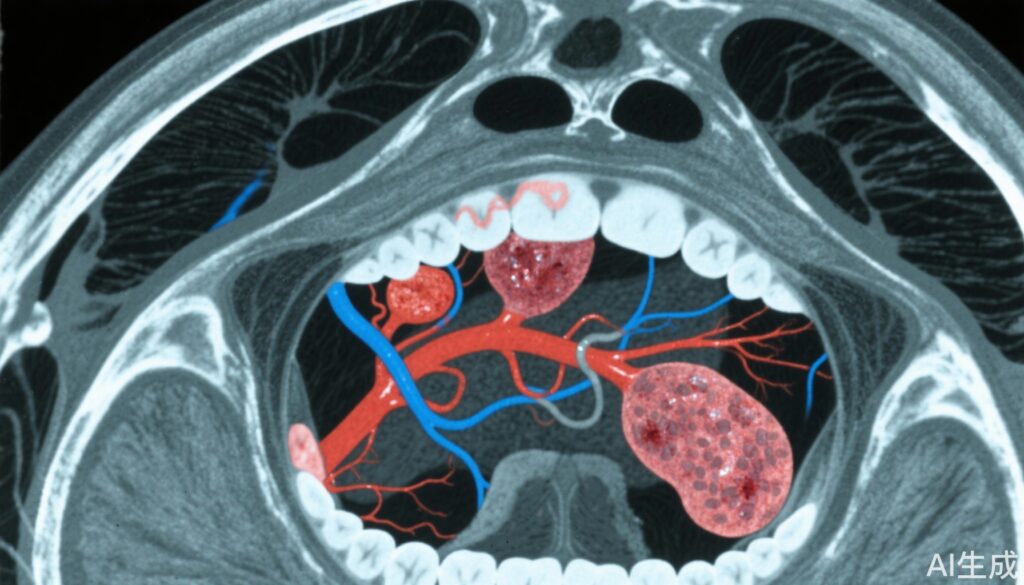Highlight
– Extranodal extension (ENE) is a critical prognostic factor in oral cavity squamous cell carcinoma (OSCC) and guides adjuvant therapy decisions.
– This study stratifies ENE into minor (≤2 mm) and major (>2 mm) categories and assesses the benefit of adjuvant chemoradiotherapy accordingly.
– Adjuvant chemotherapy significantly improves disease-free and overall survival in patients with major ENE but not in those with minor ENE.
– Findings suggest a need to reconsider treatment guidelines and personalize adjuvant therapy based on ENE extent.
Study Background and Disease Burden
Oral cavity squamous cell carcinoma (OSCC) is a significant global health issue characterized by its aggressive tumor biology and relatively poor prognosis when regional lymph node metastasis occurs. The presence of extranodal extension (ENE), where cancer cells breach the lymph node capsule to invade adjacent tissues, is recognized as an adverse prognostic marker associated with higher recurrence and lower survival rates. Current treatment guidelines recommend adjuvant chemoradiotherapy for patients with positive lymph nodes and ENE. However, ENE varies in its extent, and the distinction between minor (≤2 mm) and major (>2 mm) ENE has not been clearly integrated into treatment decision-making. The clinical question remains whether all patients with ENE uniformly benefit from adjuvant chemotherapy or if treatment should be tailored based on the extent of extranodal spread.
Study Design
This retrospective multicenter cohort study analyzed data from 755 patients with surgically resected OSCC and pathologically confirmed nodal metastasis, treated between 2005 and 2018 at four high-volume head and neck surgical centers in Australia, the United States, and Canada. Archived tissue specimens were re-evaluated to restage ENE extent as minor (≤2 mm) or major (>2 mm). Patients received adjuvant radiotherapy or chemoradiotherapy according to standard care guidelines. Outcomes assessed included locoregional control (LRC), disease-free survival (DFS), and overall survival (OS). The analyses applied univariable and multivariable Cox regression, including propensity score matching to adjust for confounding variables.
Key Findings
Among the 755 patients (mean age 61.7 years; 36% female), 126 (17%) had minor ENE, and 243 (32%) had major ENE. Adjuvant chemotherapy was administered to 39.7% of patients with minor ENE and 47.8% with major ENE. Multivariable analyses revealed that in the minor ENE subgroup, chemotherapy did not significantly improve LRC (HR 1.07; 95% CI, 0.49–2.32), DFS (HR 0.96; 95% CI, 0.56–1.66), or OS (HR 0.97; 95% CI, 0.55–1.73). Conversely, patients with major ENE receiving chemotherapy experienced significant improvements in DFS (HR 0.58; 95% CI, 0.41–0.81) and OS (HR 0.61; 95% CI, 0.38–0.98), although LRC was not significantly different.
Propensity score-matched analyses confirmed these findings: for minor ENE, chemotherapy did not significantly affect LRC (71% vs 75%), DFS (56% vs 56%), or OS (57% vs 57%). For major ENE patients, chemotherapy notably improved DFS (33% vs 11%; difference, 22%) and OS (41% vs 15%; difference, 26%) without a significant effect on LRC.
These results indicate that the survival benefit of adjuvant chemotherapy is concentrated in patients with major extranodal extension, while those with minor ENE derive minimal benefit, suggesting a potential overtreatment risk.
Expert Commentary
The study by Manojlovic-Kolarski et al. provides compelling evidence to refine adjuvant treatment paradigms in OSCC. Existing guidelines advocating for routine adjuvant chemoradiotherapy in all patients with ENE might be reconsidered to avoid unnecessary chemotherapy-associated toxicity in minor ENE cases. These findings echo biological plausibility, as major ENE likely reflects a higher tumor burden and more invasive disease warranting intensified therapy. However, limitations such as retrospective design and residual confounding cannot be ignored. Prospective validation will be essential before altering clinical practice. Moreover, integrating molecular markers and imaging modalities could further personalize treatment.
Conclusion
This large multicenter retrospective cohort study clarifies that adjuvant chemotherapy confers a survival advantage in OSCC patients with major extranodal extension but not in those with minor ENE. The findings advocate for a stratified approach to adjuvant therapy based on ENE extent, facilitating more tailored and potentially less toxic treatment regimens. Continued research and prospective trials are necessary to consolidate these findings and optimize care for OSCC patients.
References
1. Manojlovic-Kolarski M, Su S, Weinreb I, et al. Adjuvant Chemoradiotherapy for Oral Cavity Squamous Cell Carcinoma With Minor and Major Extranodal Extension. JAMA Otolaryngol Head Neck Surg. 2025;151(8):785-794. doi:10.1001/jamaoto.2025.1721
2. National Comprehensive Cancer Network. NCCN Clinical Practice Guidelines in Oncology: Head and Neck Cancers. Version 3.2024.
3. Ganly I, Patel S, Shah J. Early stage squamous cell cancer of the oral tongue—clinicopathologic features affecting outcome. Cancer. 2012;118(14):1012-1021.
4. Huang SH, O’Sullivan B. Oral cavity carcinoma: current management, controversies, and future directions. J Clin Oncol. 2013;31(32):4034-4041.


